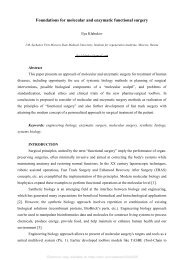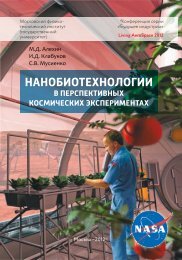Engineering Biology Problems Book (2021, Obninsk Edition)
Create successful ePaper yourself
Turn your PDF publications into a flip-book with our unique Google optimized e-Paper software.
2.16 Molecular surgery. Modern visualization and surgical techniques allow for unprecedented
precision, and Da Vinci robots demonstrate that. However, it is supposed that the usage of molecular
robots — enzymes, immune drugs, other instances of molecular machinery, and their conjugates —
has the potential for performing surgical operations via transdermal or intravenous injection. In a 1966
paper, the notion of molecular DNA surgery was coined [34]. In the modern vision, this term
corresponds to applying genome editing for treatment. Suggest methods for molecular surgery for
human embryos, including reversible.
[34. Denkewalter RG, Tishler M. Drug Research — Whence and Whither. Fortschritte der
Arzneimittelforschung / Progress in Drug Research / Progrès des recherches pharmaceutiques, Basel:
Birkhäuser Basel; 1966, p. 11–31. doi:10.1007/978-3-0348- 7059-7_1. ]
SOLUTION:
The solution for this problem is yet under development.
2.17 The term enzymatic surgery was coined in 1981 [35]. Despite the widespread usage of enzymes
for gastrointestinal system therapies, enzyme-based reconstructive solutions, e.g. metalloproteinase
delivery at the fibrous tissue overgrowth site, have not been developed.
Suggest a molecular surgery technique for a cholecystectomy (gall-bladder removal), accounting for
the high risk of cholecystolithiasis (bile duct stones). Given the necessity for toxic products removal,
propose a way to deactivate and harmonious disposal with systems and organs present in the human
organism (liver, gastrointestinal tract, kidneys, lungs, perspiration glands).
[35. Paterson MC, Bech-Hansen NT, Smith PJ. Heritable Radiosensitive and DNA Repair- Deficient
Disorders in Man. Chromosome Damage and Repair, Boston, MA: Springer US; 1981, p. 335–54.
doi:10.1007/978-1-4684-7956-0_40. ]
SOLUTION:
The solution for this problem is yet under development.
2.18 Synthetic morphogenesis. Synthetic morphogenesis is a way to replace lost tissues, organs, and
cellular function(s) by inducing local iteration of normal ontogenesis or forming organs with
fundamentally different functions [36]. Propose methods for synthetic morphogenesis of lost or
mal/non-functioning organs instead of transplantation or lifelong drug therapy.
[36. Teague BP, Guye P, Weiss R. Synthetic Morphogenesis. Cold Spring Harbor Perspectives in
Biology 2016;8:a023929. doi:10.1101/cshperspect.a023929.]
SOLUTION:
This challenge is considered in detail in Jamie A. Davies papers [37][38]. Induction of morphological
organization in vivo and in vitro, methods for shaping organoids and biodrafts are discussed.
[37,38. Davies, J. A. (2008). Synthetic morphology: prospects for engineered, self‐constructing
anatomies. Journal of Anatomy, 212(6), 707-719. Cachat, E., Liu, W., Hohenstein, P., & Davies, J. A.
(2014). A library of mammalian effector modules for synthetic morphology. Journal of biological
engineering, 8(1), 26.]
2.19 Minimally invasive transplantology. Transplantation of organs and tissues is a painful
procedure, associated with surgical intervention and a risky rehabilitation period. New technologies,
(e.g. laparoscopic methods, fast track surgery) allowed to simplify such operations. Apart from
surgical robotics, suggest some ways to reduce the labor intensity of transplantations into the
abdominal zone.
SOLUTION:
The solution for this problem is yet under development.












